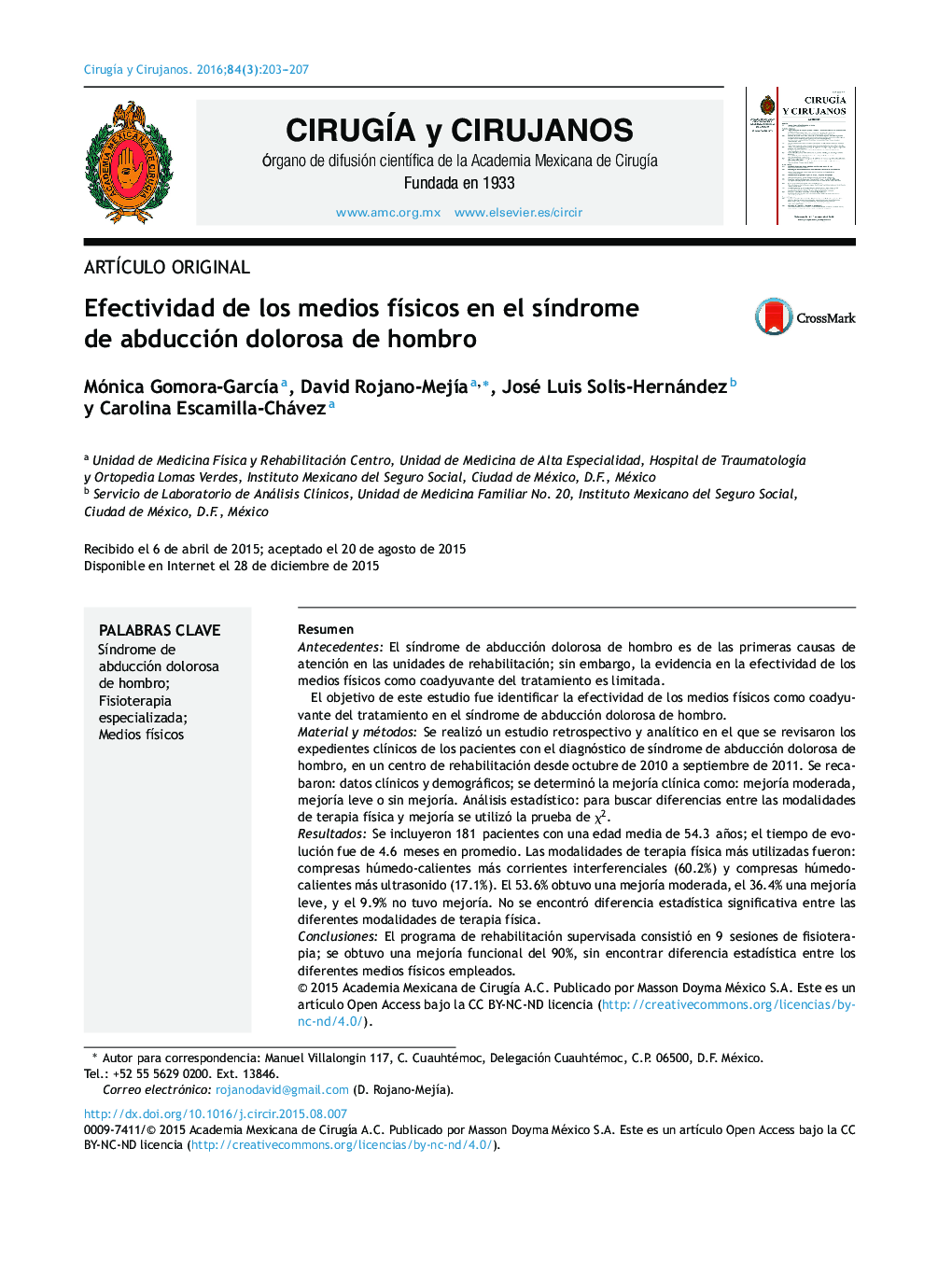| Article ID | Journal | Published Year | Pages | File Type |
|---|---|---|---|---|
| 4283164 | Cirugía y Cirujanos | 2016 | 5 Pages |
ResumenAntecedentesEl síndrome de abducción dolorosa de hombro es de las primeras causas de atención en las unidades de rehabilitación; sin embargo, la evidencia en la efectividad de los medios físicos como coadyuvante del tratamiento es limitada.El objetivo de este estudio fue identificar la efectividad de los medios físicos como coadyuvante del tratamiento en el síndrome de abducción dolorosa de hombro.Material y métodosSe realizó un estudio retrospectivo y analítico en el que se revisaron los expedientes clínicos de los pacientes con el diagnóstico de síndrome de abducción dolorosa de hombro, en un centro de rehabilitación desde octubre de 2010 a septiembre de 2011. Se recabaron: datos clínicos y demográficos; se determinó la mejoría clínica como: mejoría moderada, mejoría leve o sin mejoría. Análisis estadístico: para buscar diferencias entre las modalidades de terapia física y mejoría se utilizó la prueba de χ2.ResultadosSe incluyeron 181 pacientes con una edad media de 54.3 años; el tiempo de evolución fue de 4.6 meses en promedio. Las modalidades de terapia física más utilizadas fueron: compresas húmedo-calientes más corrientes interferenciales (60.2%) y compresas húmedo-calientes más ultrasonido (17.1%). El 53.6% obtuvo una mejoría moderada, el 36.4% una mejoría leve, y el 9.9% no tuvo mejoría. No se encontró diferencia estadística significativa entre las diferentes modalidades de terapia física.ConclusionesEl programa de rehabilitación supervisada consistió en 9 sesiones de fisioterapia; se obtuvo una mejoría funcional del 90%, sin encontrar diferencia estadística entre los diferentes medios físicos empleados.
BackgroundPainful shoulder impingement syndrome is one of the first reasons for care in rehabilitation centres. As the evidence regarding the effectiveness of physical measures as adjuvant treatment is limited, the aim of this study was to determine the effectiveness of physiotherapy on shoulder pain.Material and methodsA retrospective and analytical study was conducted using the medical records of patients with shoulder pain who attended in a rehabilitation centre from October 2010 to September 2011. The demographic and clinical data were collected, and the clinical improvement was determined as: complete, incomplete, or no improvement. Statistical analysis: Chi squared was used to determine whether there were differences between the different modalities of physiotherapy, as well as the level of improvement.ResultsThe study included a total of 181 patients, with a mean age of 54.3 years, and a mean of 4.6 months of onset of pain. The physiotherapy treatments included: warm compresses plus interferential current (60.2%), and warm compresses plus ultrasound (17.1%). Just over half (53.6%) obtained a moderate recovery, 36.4% slight improvement, and 9.9% no improvement. No significant differences were found between the different forms of therapy.ConclusionsThe supervised rehabilitation program consists of 9 sessions of physiotherapy. A functional improvement of 90% was obtained, without finding any statistical differences between the therapies used.
